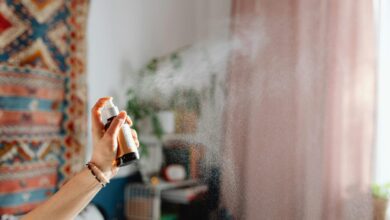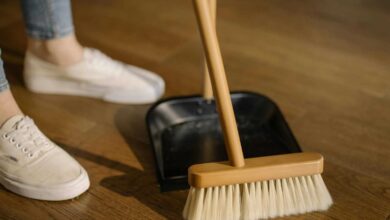Breathe Easy: Creating a Non-Toxic Home Environment

Introduction to Non-Toxic Living
The concept of non-toxic living is garnering increasing attention as more individuals become aware of the potential health risks posed by common household toxins. These toxins, often found in everyday items such as cleaning products, furniture, and even the air we breathe, can have profound effects on our overall well-being. Non-toxic living seeks to minimize or eliminate these harmful substances from our homes, creating a safer and healthier environment for all occupants.
One of the most immediate concerns associated with household toxins is their impact on respiratory health. Volatile organic compounds (VOCs), emitted by products like paints, varnishes, and air fresheners, can lead to respiratory issues ranging from mild irritation to more severe conditions such as asthma. Long-term exposure to these compounds has been linked to chronic respiratory illnesses, underscoring the importance of reducing VOCs in the home.
In addition to respiratory concerns, household toxins can also trigger allergies and other allergic reactions. Dust mites, mold, and certain chemicals found in cleaning products can exacerbate allergy symptoms, making it difficult for individuals to find relief. By adopting non-toxic living practices, it is possible to significantly reduce the presence of these allergens, creating a more comfortable and healthier living space.
The long-term health consequences of exposure to household toxins are perhaps the most alarming. Studies have shown that continuous exposure to certain chemicals can increase the risk of serious health conditions, including cancer, hormonal imbalances, and neurological disorders. These findings highlight the critical need for creating a non-toxic home environment as a preventative measure to safeguard our health.
Ultimately, the importance of non-toxic living cannot be overstated. By making informed choices and taking proactive steps to eliminate harmful substances from our homes, we can create a sanctuary that promotes better health and well-being for ourselves and our loved ones. This blog post will explore various strategies and practical tips for achieving a non-toxic home environment, empowering you to breathe easy and live healthier.
Identifying Common Household Toxins
In the quest for a non-toxic home environment, it is essential to first identify the various toxins that may be present in everyday household items. Many common cleaning products, personal care items, building materials, and furniture can harbor harmful chemicals that pose health risks. Understanding these sources and recognizing their presence is a crucial step toward mitigating their impact.
Cleaning products are one of the most prevalent sources of household toxins. Many conventional cleaners contain volatile organic compounds (VOCs), such as formaldehyde and benzene, which can cause respiratory issues, skin irritation, and long-term health problems like cancer. These compounds are often found in air fresheners, disinfectants, and polishes. Opting for natural or eco-friendly cleaning alternatives can significantly reduce exposure to these harmful substances.
Personal care items, including shampoos, lotions, and cosmetics, are another common source of household toxins. Ingredients like parabens, phthalates, and sodium lauryl sulfate are frequently used in these products. These chemicals have been linked to hormonal disruptions, reproductive harm, and allergies. Reading labels and choosing products with safer ingredients can help minimize health risks associated with personal care items.
Building materials and furniture can also contribute to a toxic home environment. Materials such as pressed wood, particleboard, and certain types of insulation can release formaldehyde and other VOCs into the air. Additionally, flame retardants used in furniture and electronics have been associated with neurological and developmental issues. To create a healthier living space, consider using low-VOC paints, natural building materials, and furniture made from solid wood or certified non-toxic materials.
Recognizing the presence of these toxins in everyday products is the first step towards creating a safer home. By being vigilant about the ingredients and materials in the items we bring into our homes, we can significantly reduce the potential health impacts of household toxins.
Choosing Non-Toxic Cleaning Products
Maintaining a clean home is essential for health and well-being, but it’s equally important to choose cleaning products that contribute to a non-toxic environment. Traditional cleaning products often contain harmful chemicals that can negatively impact indoor air quality and pose health risks. Opting for non-toxic cleaning products can mitigate these risks and promote a safer living space.
When selecting non-toxic cleaning products, it is crucial to read the labels carefully. Look for products free from harsh chemicals like ammonia, chlorine, and phthalates. Certifications such as Green Seal, EcoLogo, and EPA’s Safer Choice can guide you toward safer alternatives. These certifications ensure that the products meet stringent environmental and health criteria.
Additionally, you can consider making your own cleaning solutions using natural ingredients. Common household items like vinegar, baking soda, and essential oils can be as effective as commercial cleaners for many tasks. For instance, a mixture of vinegar and water can serve as an excellent all-purpose cleaner, while baking soda can be used as a scrubbing agent for tougher stains. Essential oils, such as tea tree oil or lavender oil, not only add a pleasant scent but also offer antibacterial properties.
Another practical tip is to avoid products with artificial fragrances. These often contain a mix of chemicals that can trigger allergies and respiratory issues. Instead, opt for fragrance-free options or those scented with natural essential oils.
By choosing non-toxic cleaning products, you can significantly reduce your household’s exposure to harmful chemicals. This proactive approach not only safeguards your health but also contributes to a more sustainable and environmentally friendly lifestyle.
Improving Indoor Air Quality
Creating a non-toxic home environment begins with improving indoor air quality. Proper ventilation plays a crucial role in ensuring that indoor spaces remain fresh and free of harmful pollutants. Regularly opening windows and doors allows for the circulation of fresh air, which helps to dilute indoor contaminants. Additionally, utilizing exhaust fans in kitchens and bathrooms can help remove excess moisture and airborne pollutants, thus reducing the risk of mold growth and other related issues.
Houseplants are another effective means of enhancing indoor air quality. Certain species of plants, such as spider plants, snake plants, and peace lilies, are known for their ability to filter out common toxins like formaldehyde and benzene. By incorporating a variety of these plants into your home decor, you can naturally purify the air while adding aesthetic appeal.
Regular maintenance of HVAC systems is essential for maintaining good indoor air quality. HVAC filters should be replaced or cleaned according to the manufacturer’s recommendations to ensure they effectively capture dust, pollen, and other airborne particles. Furthermore, scheduling professional inspections and cleanings of your HVAC system can prevent the buildup of contaminants and improve overall efficiency.
The use of air purifiers can also significantly contribute to a healthier indoor environment. High-efficiency particulate air (HEPA) filters are particularly effective at trapping a wide range of pollutants, including pet dander, dust mites, and tobacco smoke. Placing air purifiers in high-traffic areas of the home can help to maintain cleaner air throughout.
Reducing indoor pollutants is another critical step. Avoiding tobacco smoke indoors, regularly grooming pets to minimize dander, and using low-emission products for cleaning and furnishing can all contribute to a less toxic indoor atmosphere. By combining these strategies, you can create a home environment that supports better health and well-being for all occupants.
Selecting Non-Toxic Furniture and Decor
Creating a non-toxic home environment begins with selecting furniture and decor that are free from harmful chemicals. Many conventional furniture pieces contain materials that can off-gas toxic substances, contributing to indoor air pollution. To ensure a healthier living space, it is crucial to be aware of materials and chemicals to avoid and to consider safer alternatives.
Formaldehyde is a common offender found in many types of furniture, especially those made from pressed wood products like particleboard, plywood, and fiberboard. This chemical is used in adhesives and can emit harmful vapors over time. To minimize exposure, opt for solid wood furniture, which is not only durable but also free from formaldehyde-containing adhesives.
Flame retardants are another group of chemicals often used in upholstered furniture and mattresses to meet fire safety standards. However, these chemicals have been linked to various health issues, including endocrine disruption and developmental problems. To avoid flame retardants, look for furniture labeled as free from these chemicals or certified by organizations like GREENGUARD, which ensures low chemical emissions.
When selecting non-toxic furniture, consider pieces made from natural materials such as organic cotton, wool, and natural latex. These materials are less likely to contain harmful chemicals and are more eco-friendly. Additionally, furniture made from reclaimed wood or bamboo offers a sustainable and non-toxic alternative.
Second-hand and vintage furniture can also be excellent options for a non-toxic home. Older furniture pieces may have already off-gassed any harmful substances, making them safer for indoor air quality. However, it is essential to inspect these items for signs of lead paint or other hazardous materials. Sanding and refinishing vintage furniture with non-toxic finishes can provide added safety and a fresh look.
Investing in non-toxic furniture and decor is a significant step towards creating a healthier home environment. By choosing materials and products that prioritize safety and sustainability, you can reduce your exposure to harmful chemicals and enhance your overall well-being.
Creating a Non-Toxic Kitchen
Transforming your kitchen into a non-toxic haven is crucial for maintaining a healthy home environment. One of the first steps involves selecting non-toxic cookware and food storage options. Traditional non-stick cookware often contains harmful chemicals like PFOA and PTFE, which can leach into food during cooking. Instead, opt for alternatives such as stainless steel, cast iron, or ceramic cookware. These materials are not only durable but also free from harmful substances.
When it comes to food storage, materials like glass, stainless steel, and silicone are excellent choices. Plastic containers can contain BPA and other harmful chemicals that may migrate into food, especially when heated. Glass containers are a safe and sustainable option, ideal for both storage and heating. Stainless steel is another robust choice that won’t react with food, while silicone bags and wraps offer a flexible and reusable alternative to plastic.
Beyond cookware and storage, the quality of the food you bring into your kitchen is equally important. Choosing organic and locally sourced foods can significantly reduce your exposure to pesticides, herbicides, and synthetic fertilizers. Organic produce is grown without these chemicals, making it a safer option for your family. Local foods often have fewer preservatives and additives because they do not require long transportation times, ensuring fresher and healthier meals.
Moreover, seasonal and locally sourced foods can support local farmers and reduce the carbon footprint associated with food transportation. By visiting farmers’ markets or joining a local CSA (Community Supported Agriculture), you can gain access to fresh, high-quality produce while fostering a sustainable and non-toxic kitchen environment.
In essence, creating a non-toxic kitchen involves careful selection of cookware, food storage materials, and food sources. These changes, though seemingly small, can have a profound impact on the overall health and safety of your home. By making informed choices, you can ensure that your kitchen remains a place of nourishment and well-being.
Non-Toxic Personal Care Products
The importance of using non-toxic personal care products cannot be overstated. Personal care products, including toiletries and cosmetics, often contain harmful chemicals that can negatively impact health. Commonly found ingredients such as parabens, phthalates, and synthetic fragrances are known to disrupt hormonal balance, cause allergies, and may even contribute to long-term health issues.
Parabens, widely used as preservatives in cosmetics, can mimic estrogen in the body, potentially leading to hormonal imbalances. Phthalates, often found in fragrances, are linked to reproductive toxicity and developmental issues. Synthetic fragrances, while adding appealing scents to products, can contain hundreds of undisclosed chemicals, many of which are known allergens and irritants.
Choosing safer alternatives involves being diligent about reading labels and understanding the ingredients listed. Opt for products labeled as “paraben-free,” “phthalate-free,” and “fragrance-free” or those that specify the use of natural fragrances. Additionally, products certified by reputable organizations such as USDA Organic or bearing the EWG Verified mark offer an added layer of trust in their non-toxic claims.
Embracing natural and organic personal care products brings numerous benefits. These products often use plant-based ingredients and essential oils, which are gentler on the skin and less likely to cause adverse reactions. Organic products, free from synthetic pesticides and fertilizers, reduce the body’s exposure to potentially harmful chemicals. Moreover, these products are typically more environmentally sustainable, contributing to a healthier planet.
Incorporating non-toxic personal care products into daily routines is a step towards a healthier lifestyle. It reduces the cumulative exposure to harmful chemicals and supports overall well-being. As consumers become more informed and demand safer options, the market for non-toxic personal care products continues to grow, providing a wider array of choices for those committed to living a healthier, toxin-free life.
Maintaining a Non-Toxic Home Environment
Creating a non-toxic home environment is a commendable first step, but maintaining it over time requires ongoing effort and vigilance. Regular cleaning and decluttering are fundamental to this process. Using natural cleaning products can significantly reduce the presence of harmful chemicals. Opt for solutions like vinegar, baking soda, and essential oils, which are effective yet gentle alternatives to conventional cleaners. Frequent dusting and vacuuming are also crucial, as dust can harbor toxins and allergens that compromise indoor air quality.
Ongoing education is another critical aspect of maintaining a non-toxic home. The market is continuously evolving, with new products and materials emerging that may be safer or more hazardous than their predecessors. Staying informed about these developments can help you make better choices. Subscribing to newsletters from reputable health and environmental organizations, and attending workshops or online webinars, can provide valuable insights. Reading labels carefully and understanding the ingredients in household products is essential for making informed decisions.
Being aware of potential hazards is also key. This includes not just the products you bring into your home but also the materials used in home renovations and furnishings. For instance, many paints, adhesives, and furniture finishes contain volatile organic compounds (VOCs) that can off-gas toxic fumes. Opt for low-VOC or VOC-free alternatives whenever possible. Additionally, regular maintenance of ventilation systems and the use of air purifiers can help mitigate the impact of any residual toxins.
The long-term benefits of maintaining a non-toxic home are substantial. A cleaner, safer environment contributes to overall health and wellness, reducing the risk of respiratory issues, allergies, and other health problems. By committing to these practices, you not only protect your family’s well-being but also contribute to a healthier planet. The journey towards a non-toxic home is ongoing, but the rewards make it a worthwhile endeavor.
Breathe Easy: Creating a Non-Toxic Home Environment – FAQ
1. What are the benefits of a non-toxic home environment?
Living non-toxic reduces exposure to chemicals linked to health problems like respiratory issues, allergies, and even some cancers. It creates a cleaner, healthier space for you and your family.
2. Where should I start with creating a non-toxic home?
Focus on the areas you spend the most time in, like bedrooms and living areas. Breathe Easy can guide you room by room with recommendations for cleaning products, materials, and ventilation strategies.
3. What types of toxins are commonly found in homes?
Common household toxins include volatile organic compounds (VOCs) from paints, cleaners, and furniture, as well as chemicals like flame retardants and pesticides.
4. How can Breathe Easy help me identify toxins in my home?
Breathe Easy offers resources to educate you on common toxins and their sources. We can also suggest testing kits for air and dust to pinpoint specific concerns.
5. What are some easy swaps I can make for safer cleaning products?
Replace harsh chemicals with natural alternatives like vinegar, baking soda, and castile soap. Breathe Easy provides DIY cleaning recipe suggestions.
6. I’m overwhelmed by all the non-toxic product options. How do I choose?
Breathe Easy curates lists of vetted non-toxic cleaning products, furniture materials, and air purifiers to simplify your selection process.
7. What about things like dust mites and mold? Can Breathe Easy help?
Yes! Breathe Easy offers guidance on creating a healthy indoor climate that discourages dust mites and mold growth. This includes proper ventilation strategies, humidity control tips, and recommendations for allergen-reducing bedding.
8. How can I improve the air quality in my home?
Breathe Easy suggests air purification strategies like using HEPA air filters, increasing ventilation with fans and open windows (when safe), and eliminating sources of indoor air pollution.
9. Is creating a non-toxic home expensive?
Breathe Easy provides budget-friendly tips and emphasizes prioritizing swaps in key areas. Many non-toxic solutions can save you money in the long run by reducing reliance on harsh cleaners and disposable products.
10. I’m worried about creating a perfect non-toxic environment. Is that even possible?
Focus on progress, not perfection! Breathe Easy encourages small, achievable steps that gradually reduce your exposure to toxins and create a healthier home.





